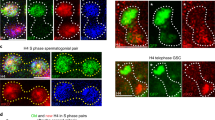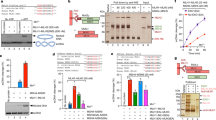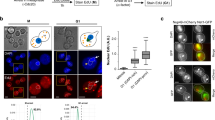Abstract
The fission yeast Schizosaccharomyces pombe normally has haploid cells of two mating types, which differ at the chromosomal locus mat1. After two consecutive asymmetric cell divisions, only one in four ‘grand-daughter’ cells undergoes a ‘mating-type switch’, in which genetic information is transferred to mat1 from the mat2-P or mat3-M donor loci1,2,3,4. This switching pattern probably results from an imprinting event at mat1 that marks one sister chromatid in a strand-specific manner3,4,5, and is related to a site-specific, double-stranded DNA break at mat16,7. Here we show that the genetic imprint is a strand-specific, alkali-labile DNA modification at mat1. The DNA break is an artefact, created from theimprint during DNA purification. We also propose and test themodel that mat1 is preferentially replicated by a centromere-distal origin(s), so that the strand-specific imprint occurs only during lagging-strand synthesis. Altering the origin of replication, by inverting mat1 or introducing an origin of replication, affects the imprinting and switching efficiencies in predicted ways. Two-dimensional gel analysis confirmed that mat1 is preferentially replicated by a centromere-distal origin(s). Thus, the DNA replication machinery may confer different developmental potential to sister cells.
This is a preview of subscription content, access via your institution
Access options
Subscribe to this journal
Receive 51 print issues and online access
$199.00 per year
only $3.90 per issue
Buy this article
- Purchase on Springer Link
- Instant access to full article PDF
Prices may be subject to local taxes which are calculated during checkout





Similar content being viewed by others
References
Miyata, H. & Miyata, M. Mode of conjugation in homothallic cells of Schizosaccharomyces pombe. J.Gen. Appl. Microbiol. 27, 365–371 (1981).
Egel, R. & Eie, B. Cell lineage asymmetry in Schizosaccharomyces pombe : unilateral transmission of a high-frequency state of mating-type switching in diploid pedigrees. Curr. Genet. 12, 429–433 (1987).
Klar, A. J. S. Differentiated parental DNA strands confer developmental asymmetry on daughter cells in fission yeast. Nature 326, 466–470 (1987).
Klar, A. J. S. The developmental fate of fission yeast cells is determined by the pattern of inheritance of parental and grandparental DNA strands. EMBO J. 9, 1407–1415 (1990).
Klar, A. J. S. & Bonaduce, M. J. The mechanism of fission yeast mating-type interconversion: evidence for two types of epigenetically inherited chromosomal imprinted events. Cold Spring Harb. Symp. Quant. Biol. 58, 457–465 (1993).
Beach, D. H. Cell type switching by DNA transposition in fission yeast. Nature 305, 682–687 (1983).
Nielsen, O. & Egel, R. Mapping the double-strand breaks at the mating-type locus in fission yeast by genomic sequencing. EMBO J. 8, 269–276 (1989).
Klar, A. J. S. & Miglio, L. M. Initiation of meiotic recombination by double-strand DNA breaks in S.pombe. Cell 46, 725–731 (1986).
Moreno, S. A., Klar, A. J. S. & Nurse, P. Molecular genetic analysis of fission yeast Schizosaccharomyces pombe. Methods Enzymol. 194, 795–823 (1991).
Egel, R., Beach, D. H. & Klar, A. J. S. Genes required for initiation and resolution steps of mating-type switching in fission yeast. Proc. Natl Acad. Sci. USA 81, 3481–3485 (1984).
Singh, J. & Klar, A. J. S. DNA polymerase-α is essential for mating-type switching in fission yeast. Nature 361, 271–273 (1993).
Caddle, M. S. & Calos, M. P. Specific initiation at an origin of replication from Schizosaccharomyces pombe. Mol. Cell. Biol. 14, 1796–1805 (1994).
Clyne, R. K. & Kelly, T. J. Genetic analysis of an ARS element from the fission yeast Schizosaccharomyces pombe. EMBO J. 14, 6348–6357 (1995).
Brewer, B. J., Lockshon, D. & Fangman, W. L. The arrest of replication forks in the rDNA of yeast occurs independently of transcription. Cell 71, 267–276 (1992).
Arcangioli, B. Asite- and strand-specific DNA break confers asymmetric switching potential in fission yeast. EMBO J. 17, 4503–4510 (1998).
Klar, A. J. S. Lineage-dependent mating-type transposition in fission and budding yeast. Curr. Opin. Genet. Dev. 3, 745–751 (1993).
Sambrook, J., Fritsch, E. F. & Maniatis, T. Molecular Cloning: A Laboratory Manual2nd ed (Cold Spring Harbor Laboratory Press, New York, (1989).
MacDonell, M. W., Simon, M. W. & Studier, F. W. Analysis of restriction fragments of T7 DNA and determination of molecular weights by electrophoresis in neutral and alkaline gels. J. Mol. Biol. 110, 119–146 (1977).
Egel, R. in Molecular Biology of the Fission Yeast (eds Nasim, A., Young, P. &Johnson, B. F.) 31–74 (Academic, San Diego, (1989).
Klar, A. J. S., Ivanova, A. V., Dalgaard, J. Z., Bonaduce, M. J. & Grewal, S. I. S. in Epigenetics (ed. Cardew, G.) 87–103 (Novartis Foundation Symposium 214, Wiley, Chichester, (1998).
Arcangioli, B. & Klar, A. J. S. Anovel switch-activating site (SAS1) and its cognate binding factor (SAP1) required for efficient mat1 switching in Schizosaccharomyces pombe. EMBO J. 10, 3025–3032 (1991).
Styrkarsdottir, U., Egel, R. & Nielsen, O. The smt-0 mutation which abolishes mating-type switching in fission yeast is a deletion. Curr. Genet. 23, 184–186 (1993).
Gerring, S. L., Connelly, C. & Hieter, P. in Guide to Yeast Genetics and Molecular Biology (eds Fink, G. &Guthrie, C.) 57–76 (Academic, San Diego, (1991).
Bresch, C., Muller, G. & Egel, R. Genes involved in meiosis and sporulation of a yeast. Mol. Gen. Genet. 102, 301–306 (1968).
Acknowledgements
We thank our colleagues at ABL for suggestions and helpful discussions; B. Brewer, M. Hoant and S. Hunt for help with the analysis of replication intermediates; A. Arthur for editorial suggestions; and R. Frederickson for the art work. This work was sponsored by the Danish Natural Science Research Council (J.Z.D.) and the National Cancer Institute, Department of Health and Human Services, under contract with ABL. The contents of this article do not necessarily reflect the views or politics of the DHHS, nor does mention of trade names, commercial products, or organizations imply endorsement by the US Government.
Author information
Authors and Affiliations
Corresponding author
Rights and permissions
About this article
Cite this article
Dalgaard, J., Klar, A. Orientation of DNA replication establishes mating-type switching pattern in S. pombe. Nature 400, 181–184 (1999). https://doi.org/10.1038/22139
Received:
Accepted:
Issue Date:
DOI: https://doi.org/10.1038/22139
This article is cited by
-
RNA insertion in DNA as the imprint moiety: the fission yeast paradigm
Current Genetics (2019)
-
Repeated evolution of self-compatibility for reproductive assurance
Nature Communications (2018)
-
Unbiased segregation of fission yeast chromosome 2 strands to daughter cells
Chromosome Research (2013)
-
Sorting DNA with asymmetry: a new player in gene regulation?
Chromosome Research (2013)
-
Mus81 is essential for sister chromatid recombination at broken replication forks
The EMBO Journal (2008)
Comments
By submitting a comment you agree to abide by our Terms and Community Guidelines. If you find something abusive or that does not comply with our terms or guidelines please flag it as inappropriate.



